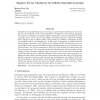80 search results - page 7 / 16 » Improved functional prediction of proteins by learning kerne... |
ICML
2004
IEEE
14 years 8 months ago
2004
IEEE
In this paper, we present a graphical model for protein secondary structure prediction. This model extends segmental semi-Markov models (SSMM) to exploit multiple sequence alignme...
ARTMED
2004
13 years 7 months ago
2004
Successful secondary structure predictions provide a starting point for direct tertiary structure modelling, and also can significantly improve sequence analysis and sequence-stru...
BMCBI
2008
13 years 7 months ago
2008
Background: Applications of computational methods for predicting protein functional linkages are increasing. In recent years, several bacteria-specific methods for predicting link...
NIPS
2008
13 years 9 months ago
2008
Metal binding is important for the structural and functional characterization of proteins. Previous prediction efforts have only focused on bonding state, i.e. deciding which prot...
JMLR
2008
13 years 7 months ago
2008
Ensemble learning algorithms such as boosting can achieve better performance by averaging over the predictions of some base hypotheses. Nevertheless, most existing algorithms are ...

